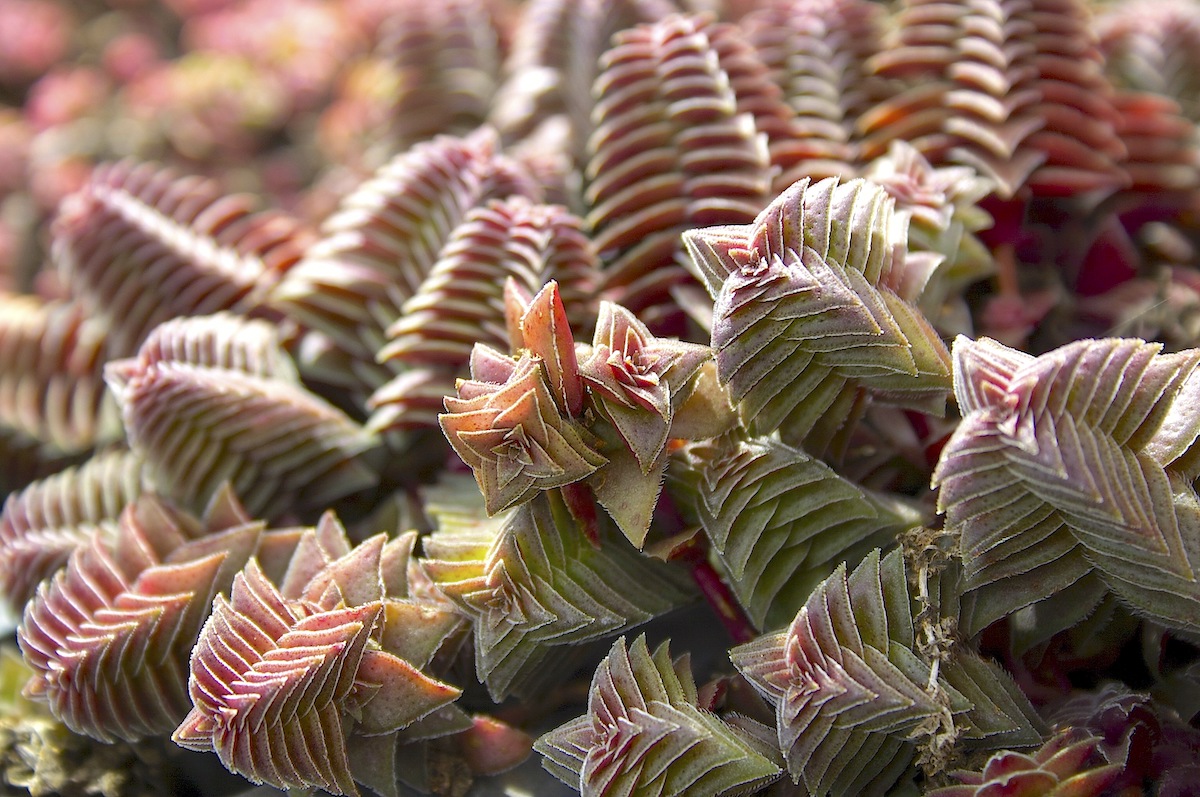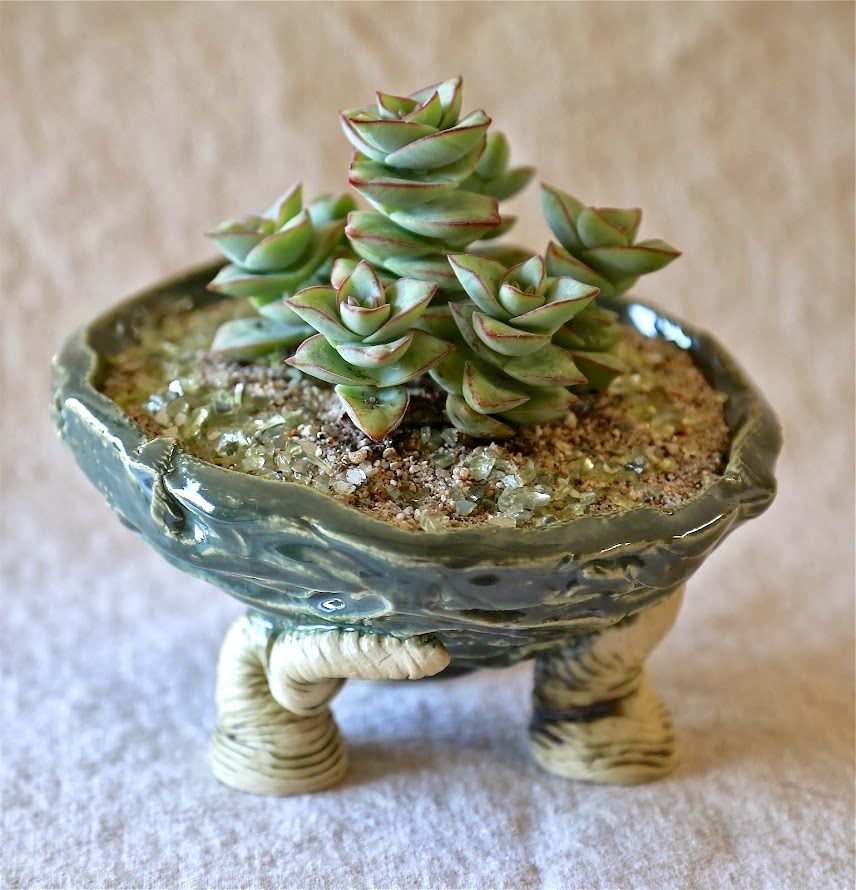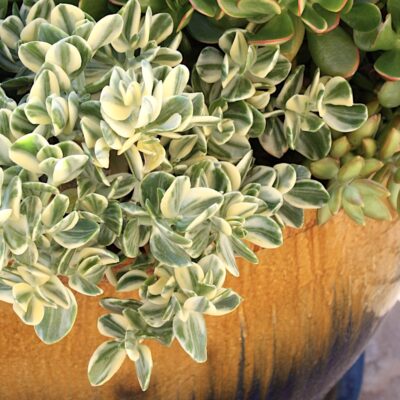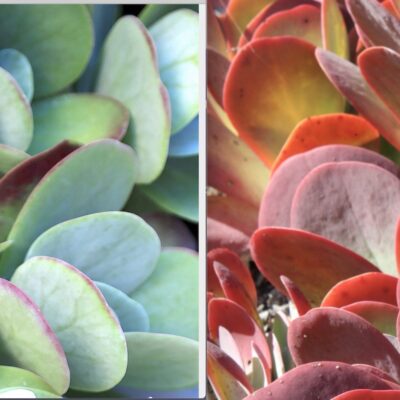
Discover Stacked Crassulas
My love affair with stacked crassulas began three decades ago. On a garden tour I saw a succulent with leaves stacked like pancakes along pendant stems. I took photos and finally tracked down the plant (Crassula perforata) several years later. Today stacked crassulas are much easier to come by, and desirable varieties number in the dozens.

Crassula perforata in a Mark Rafter pot
What's a stacked crassula?
"Stacked crassula" describes those species and cultivars in the genus Crassula with stems that go through the middle of the leaves. This creates what looks like stacks of bagels, beads on a necklace, minarets, pagodas, alternating plus-signs, rounded stars, rattler tails, pinwheels and more.

Crassula deceptor
Leaves vary from chunky (Crassula 'Moonglow') to dainty (Crassula 'Petite Bicolor'). Colors range from silvery white (Crassula deceptor) through shades of blue, green, brown and maroon. Flowers are tiny and clustering---similar to those of jade plants (one reason they're in the same genus). Stems vary from green "watch chains" (Crassula muscosa) to caterpillars (Crassula 'Baby's Necklace'). Go to the Crassula Gallery.
Stacked Crassula video
I'm so proud of my comprehensive, eye-candy video and eager for you to see 20+ collectible, easy-care and endearing varieties. Each has its own form, color and personality. In the video, you'll learn names, how to care for them, see them showcased in pots, and find out how to take cuttings. Yes, it's possible to propagate succulents with leaves so tight they conceal the stems! And---spoiler alert---it's easy.
Because names vary...
I've painstakingly researched plant names, which tend to be confusing or inaccurate online. I suspect this has to do with the same variety looking different depending on sun exposure, and vendors trying to ID plants from photos. Also to assist my viewers, I tracked down the parentage of crosses and cultivars, and (with glee I hope you share...or at least are patient with), I translate intimidating-yet-insightful Latin names.

Crassula pellucida 'Petite Bicolor' (Little Missy) is among the more delicate stacked crassulas
Where and how to grow them
Stacked crassulas are too small to grow in the open garden---at least in mine, where they'd soon be engulfed or forgotten. Where I live in the foothills northeast of San Diego (Zone 9b), I grow stacked crassulas in pots in sheltered outdoor areas. Like shrub crassulas (jade plants), stacked species are frost-tender.
Growing indoors shouldn't be a problem; most are suited to windowsill pots. Thicker-leaved varieties want less water than thin-leaved ones, and are more likely to rot if overwatered. All want as much sun as possible, short of burning. They do fine in dappled shade, but will reward you by reddening and flowering in greater sun. A few hours of full sun in the morning or late afternoon should do it.
See My Gallery of Varieties
Go to my Crassula page for care-and-cultivation info and a comprehensive gallery of plants, all ID'd.
Shop for Stacked Crassulas
An online source with a consistent inventory and good selection is Mountain Crest Gardens. Not to mention their nomenclature is reliable (yay!). Also look for rarities at Cactus & Succulent Society shows and succulent specialty nurseries. Oasis Water Efficient Gardens in San Diego's North County consistently offers the more common varieties. If you can recommend other sources, do mention them in the comments.
Related Videos and Links
- Watch my DIY planting demo: Stacked Crassulas in Stacked Pots
- See how nursery manager Aaron Ryan propagates stacked crassulas
- Find out why crassulas turn red (and how to help them do so) on my Stressing Succulents page
- Get a strawberry pot for your collection of stacked crassulas
Crassula (Jade and More): Details, Photos and Varieties
Crassulas are among the easiest, most trouble-free succulents to grow, with one caveat: With few exceptions, they’re frost-tender (tend to be damaged when temperatures drop below 32 degrees F). Shrub varieties are very easy to start from cuttings, and stacked jades will send forth whiskery roots from between their tight leaves—simply snip off the stem and bury in potting soil so that roots are covered (it’s OK to bury a few leaves too). Crassulas, like aloes, also stress beautifully to shades of red, yellow and orange. Give variegated varieties adequate sun or they’ll revert to solid green.
Are Your Succulents Well Stressed? 50 Before-and-Afters
Are your succulents well stressed? Given the right conditions, certain varieties turn from green or blue to brilliant reds, oranges and yellows. See 50 before-and-afters. How much a succulent “colors up” depends on…


